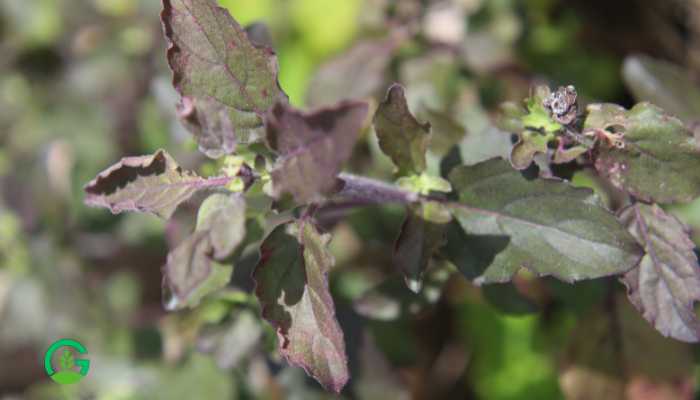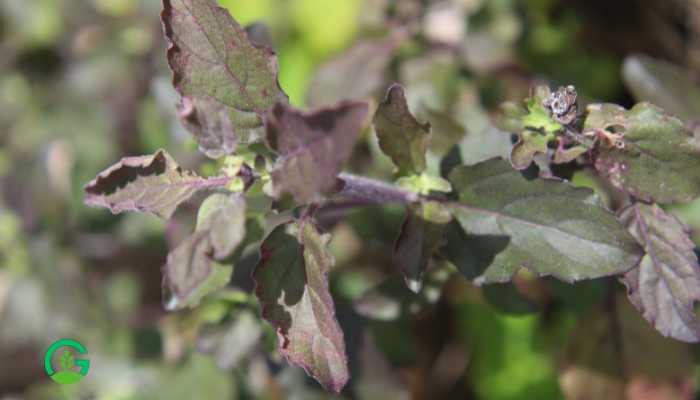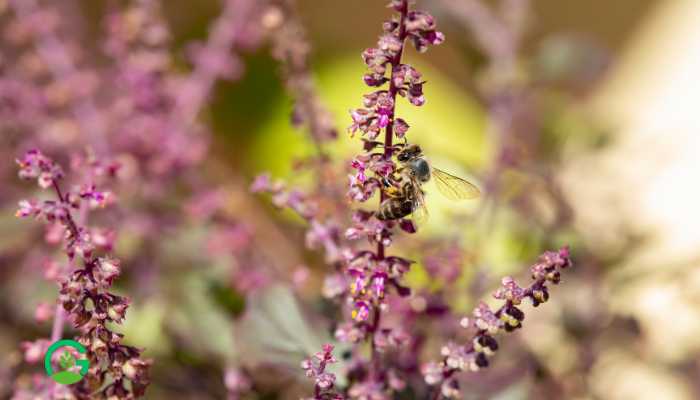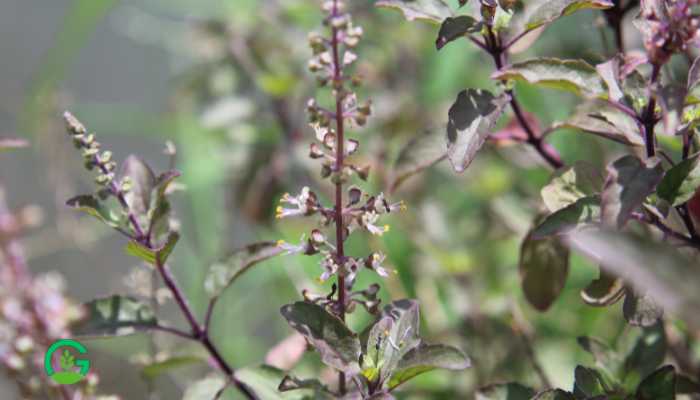Growing a Krishna Tulsi plant is like inviting a piece of Indian tradition and wellness into your home. Known for its aromatic leaves and revered in Hindu culture, Krishna Tulsi, also known as Shyama Tulsi, is a variant of the Holy Basil.
It’s not just a plant; it’s a symbol of purity, and its medicinal properties are celebrated worldwide.
In this comprehensive guide, we’ll walk you through everything you need to know about growing and caring for your Krishna Tulsi plant, making it a healthy and vibrant addition to your garden.
Krishna Tulsi Plant Table of Contents
Introduction to Krishna Tulsi
Krishna Tulsi is not just another herb; it’s a cornerstone of Ayurvedic medicine and Hindu spirituality. With its dark purple leaves and strong aroma, it’s easily distinguishable from other varieties of basil.
People often grow it for its health benefits, which include boosting immunity, reducing stress, and promoting respiratory health. But how do you ensure that your Krishna Tulsi thrives? Let’s dive in!

Choosing the Right Spot
Selecting the perfect location for your Krishna Tulsi is crucial. This plant loves sunlight, so find a spot that gets at least 6-8 hours of direct sunlight each day. A sunny windowsill or a south-facing garden bed can be ideal. Think of it as choosing a home with a great view and plenty of sunshine—it makes all the difference!
Planting Krishna Tulsi
Starting from Seeds or Cuttings
You can start your Krishna Tulsi from seeds or cuttings. If you’re using seeds, plant them in small pots filled with a good potting mix. Sow the seeds about 1/4 inch deep and keep the soil moist. If you prefer using cuttings, take a healthy stem from an existing plant and place it in water until roots develop.
Transplanting Seedlings
Once the seedlings have grown a few inches tall and have developed a couple of sets of leaves, they’re ready to be transplanted into the garden or a larger pot. Make sure the soil is well-draining, and dig a hole that is large enough to accommodate the root ball.

Soil Requirements
Ideal Soil Composition
Krishna Tulsi thrives in well-drained soil with a neutral pH level. A mix of garden soil, sand, and compost works best. Think of the soil as the foundation of a house—strong and supportive. It should be fertile and rich in organic matter to ensure that the plant gets all the nutrients it needs.
Soil Preparation
Before planting, loosen the soil and mix in some compost or aged manure. This not only enriches the soil but also improves its structure and drainage. Ensure the soil is not too compacted, as this can hinder root growth.
Watering Krishna Tulsi Plant
Establishing a Watering Routine
Watering your Krishna Tulsi plant correctly is essential. The soil should be kept moist but not waterlogged. Overwatering can lead to root rot, while underwatering can cause the plant to wilt. A good rule of thumb is to water the plant when the top inch of soil feels dry to the touch.
Seasonal Watering Needs
During the hot summer months, your Tulsi might need more frequent watering, whereas, in the cooler seasons, you can reduce the frequency. Always adjust your watering schedule based on the weather and the plant’s needs.

Sunlight and Temperature Needs
Optimal Sunlight Exposure
Krishna Tulsi loves the sun. Ensure your plant gets at least 6-8 hours of direct sunlight daily. Inadequate sunlight can lead to poor growth and weaker plants. If you’re growing it indoors, place it near a sunny window or use grow lights.
Temperature Tolerance
This plant prefers warm temperatures. It thrives in temperatures between 70°F to 95°F (21°C to 35°C). Protect it from frost, as cold temperatures can damage the plant. If you live in a region with harsh winters, consider growing Krishna Tulsi in a pot so you can bring it indoors when needed.
Fertilizing Tips
Choosing the Right Fertilizer
Feeding your Krishna Tulsi with the right nutrients is crucial for its growth. Use an organic fertilizer rich in nitrogen. Compost or well-rotted manure can also work wonders. Fertilize the plant every 4-6 weeks during the growing season.
Avoid Over-Fertilization
Over-fertilizing can do more harm than good. It can lead to excessive leaf growth at the expense of flower production. Stick to a balanced feeding schedule and adjust based on the plant’s response.
Pruning and Harvesting
Pruning for Better Growth
Regular pruning helps in maintaining the shape of your Krishna Tulsi and promotes bushier growth. Trim the top 2-3 inches of the plant regularly. This not only helps in keeping the plant compact but also encourages the growth of new leaves.
Harvesting Leaves
The best time to harvest Tulsi leaves is in the morning when the essential oils are at their peak. Pick the leaves as needed, but avoid stripping the plant of too many leaves at once. Regular harvesting can also promote new growth.
Image | Product Name | Review | Price |
Pest and Disease Management
Common Pests
Krishna Tulsi can be susceptible to pests like aphids, spider mites, and whiteflies. Regularly inspect your plant for any signs of pests. Use organic insecticidal soap or neem oil to keep these pests at bay.
Disease Prevention
Fungal diseases like powdery mildew can affect your Tulsi. Ensure good air circulation around the plant and avoid overhead watering to prevent such issues. If you notice any diseased leaves, remove them immediately to prevent the spread.
Winter Care for Krishna Tulsi Plant
Protecting from Frost
If you live in a region with cold winters, you need to take special care of your Krishna Tulsi. Bring potted plants indoors or cover garden plants with frost cloth. Keeping the plant in a sunny spot indoors can help it survive the winter.
Reducing Watering
During winter, the growth rate of the plant slows down. Reduce the watering frequency and let the soil dry out slightly between watering. This helps in preventing root rot due to cold and damp conditions.
Medicinal Uses and Benefits
Health Benefits
Krishna Tulsi is renowned for its numerous health benefits. It’s often used to boost immunity, reduce stress, and improve respiratory health. The leaves can be used to make tea, which is known to have calming effects and helps in detoxifying the body.
Traditional Uses
In Ayurveda, Krishna Tulsi is considered a potent adaptogen, which helps the body adapt to stress. It’s also used in various home remedies for treating common ailments like colds, coughs, and digestive issues.

Common Problems and Solutions
Yellowing Leaves
If your Tulsi’s leaves are turning yellow, it might be due to overwatering or nutrient deficiencies. Ensure the soil drains well and avoid waterlogging. A balanced fertilizer can help in replenishing essential nutrients.
Wilting Plant
A wilting Tulsi plant can be a sign of underwatering or root damage. Check the soil moisture and adjust your watering schedule. If the roots are damaged, replanting in fresh soil might be necessary.
Read More
Propagating Krishna Tulsi
From Seeds
To propagate Krishna Tulsi from seeds, sow them in a seed tray filled with a light potting mix. Keep the soil moist and place the tray in a warm, sunny location. Seedlings will emerge in about 1-2 weeks.
From Cuttings
Take a healthy cutting from an established plant, remove the lower leaves, and place it in water or moist soil. In a few weeks, roots will develop, and the cutting can be transplanted to a pot or garden.
Conclusion
Growing and caring for a Krishna Tulsi plant is a rewarding experience. Not only does it bring a touch of nature into your home, but it also offers numerous health benefits.
With the right care and attention, your Krishna Tulsi can thrive and become a cherished part of your garden. Whether you’re a seasoned gardener or a beginner, this guide provides all the information you need to cultivate a healthy and vibrant Krishna Tulsi plant.
Krishna Tulsi Plant FAQs
How often should I water my Krishna Tulsi plant?
Water your Krishna Tulsi when the top inch of soil feels dry. This usually means watering every 2-3 days, but it can vary based on the climate and season.
Can I grow Krishna Tulsi indoors?
Yes, you can grow Krishna Tulsi indoors. Place it near a sunny window where it can get at least 6 hours of direct sunlight daily.
What are the medicinal benefits of Krishna Tulsi?
Krishna Tulsi is known for its health benefits, including boosting immunity, reducing stress, and improving respiratory health. It’s often used in teas and traditional remedies.
How do I protect my Krishna Tulsi plant from pests?
Regularly inspect your plant for pests like aphids and spider mites. Use organic insecticidal soap or neem oil to treat infestations.
Can I use regular garden soil for planting Krishna Tulsi?
Krishna Tulsi prefers well-drained soil rich in organic matter. If your garden soil is heavy, mix it with sand and compost to improve drainage and fertility.




















